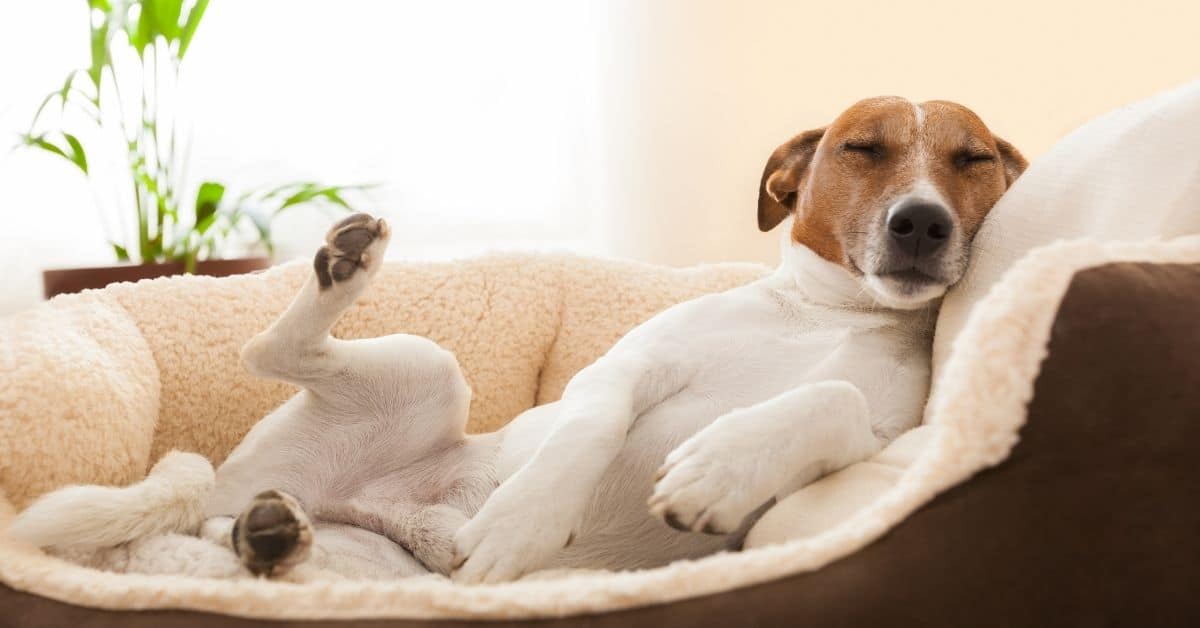Have you ever noticed your dog twitching, whining, or even running in their sleep?
And have you ask yourself then “Why do dogs run in their sleep”?
In this article, we reveal the reasons for dog’s running behavior during sleep and share with you what you need to do about it.
Canine Sleep Cycle: A Deep Dive
Just as with humans, dogs’ sleep is far more complex than it might initially seem.
There’s a whole world of activity happening beneath those closed eyes, much of it incredibly important for their overall health and wellbeing.
Understanding Canine Sleep Patterns
Dogs sleep more than humans, and their sleep cycle is more frequent but shorter.
They experience two main stages of sleep: Rapid Eye Movement (REM) and Non-Rapid Eye Movement (NREM).
Dogs spend about 44% of their time in alert wakefulness, 23% in drowsy wakefulness, 23% in non-REM sleep, and 12% in REM sleep.
The Role Of Rem Sleep
It’s during the REM stage that dogs dream and show physical responses to those dreams.
In this stage, their brain activity increases, matching levels experienced during wakefulness.
The REM stage is when dogs may exhibit signs of dreaming – just like humans do.
They might move their legs as if they are running, make noises, or even wag their tails.
Decoding Sleep Movements: The Role Of Dreams
Watching your dog sleep can be entertaining and endearing, but it also gives insight into their dream world.
Do Dogs Dream?
Studies suggest that dogs do indeed dream.
Scientists have found similarities between humans and animals in the brain wave patterns during sleep.
Plus, the brain structures involved in dreaming in humans are also present in dogs.
It’s thought that dogs likely dream about their daily experiences, much as humans do.
The Link Between Dreams And Movements
The “running” you see is likely a physical manifestation of your dog’s dreams.
During REM sleep, dogs’ brains are active, and they are immersed in their dream world.
They might be dreaming of chasing a ball, playing with friends, or running in a meadow.
What you’re seeing is a dog totally engrossed in their dream world, so much so that their dream actions are spilling out into the real world.
Is ‘Sleep Running’ A Cause For Concern?
The sight of our dogs “running” in their sleep may seem odd, and sometimes, it might even concern us.
So, when should you worry?
The key lies in distinguishing between normal dream responses and potential sleep disorders.
Normal Sleep Behavior Vs. Sleep Disorders
The occasional twitch, yelp, or leg jerk is usually a harmless part of your dog’s dream sequence.
However, if these actions become violent, prolonged, or are paired with other concerning signs such as difficulty breathing, it could be a sign of a sleep disorder.
For example, REM Sleep Behavior Disorder (RBD) is a condition where dogs ‘act out’ their dreams, often leading to injury.
When To Consult A Vet
While occasional “sleep running” is typically normal, changes in your dog’s sleep behavior or extreme movements should be discussed with a veterinarian.
If your dog’s sleep movements become more violent, frequent, or if they seem disoriented or agitated upon waking, it’s time to consult a professional.
A sudden onset of strange sleep behavior could be a sign of a health issue that requires attention.
Fostering A Safe Sleep Environment For Active Sleepers
As owners, our role extends to creating a secure sleep environment, especially if our dogs are active dreamers.
Bedtime Safety For Dogs
Ensure that your dog’s sleeping area is safe.
If your dog is an active dreamer, consider a bed with sides or a large cushion to prevent falling off.
Remove any sharp or hard objects nearby that they might bump into.
The Importance Of Quality Sleep For Dogs
Just like humans, dogs need quality sleep for their overall health.
It impacts their mood, energy levels, memory, and even their immune system.
Ensuring your dog gets plenty of undisturbed rest is one of the best ways you can contribute to their wellbeing.
In the wonderful world of dogs, even sleep is filled with action.
Our dogs’ “sleep running” gives us a fascinating glimpse into their dream lives.
As responsible pet parents, our role is to understand these behaviors, ensure they signify healthy sleep patterns, and provide a safe, comfortable sleep environment for our dogs.
So the next time your dog chases a dream rabbit, you’ll know there’s typically no cause for concern – they’re just exploring their dream world!
Before You Go…
Now you know why dogs run in their sleep.
If you want to learn more, read the following articles too!
Or watch this video:


